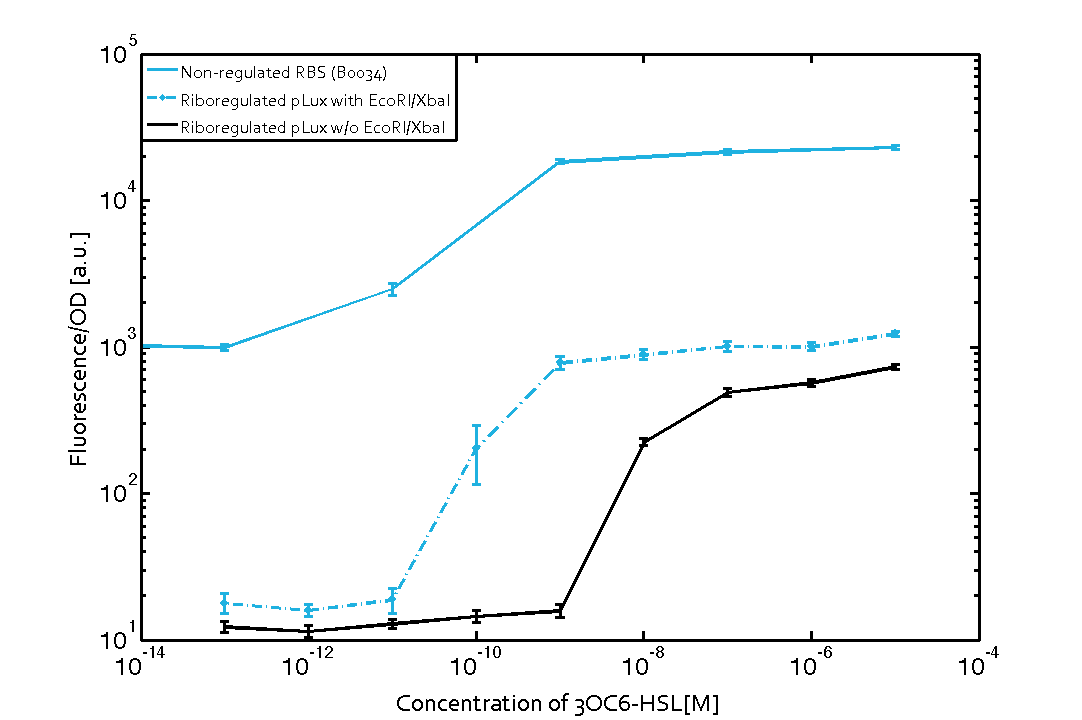Difference between revisions of "Part:BBa K1541009"
| Line 13: | Line 13: | ||
===Usage and Biology=== | ===Usage and Biology=== | ||
| − | ===Background=== | + | Expression of sfGFP is induced when [https://parts.igem.org/Part:BBa_C0171 RhlR (BBa_C0171)], bound to [[AHL|4C-HSL]], activates the promoter [https://parts.igem.org/Part:BBa_C0062 pRhl (BBa_R0071)]. The ''cis''-repressive element (crR12y, 'lock') inhibits the translation of sfGFP, since the [https://parts.igem.org/Part:BBa_B0034 RBS (BBa_B0034)] is blocked by secondary structures of the mRNA. The transcript of the ''trans''-activating element (taR12y, 'key', also under the control of [https://parts.igem.org/Part:BBa_C0062 pRhl (BBa_R0071)]) binds to the transcript of the cis-repressive element, hence the RBS is not blocked anymore. The two elements build a riboregulator ('key' and 'lock') that decreases leakiness of [https://parts.igem.org/Part:BBa_C0062 pRhl (BBa_R0071)]. |
| + | |||
| + | ===Background Information=== | ||
| + | |||
| + | We used an ''E. coli'' TOP10 strain transformed with two medium copy plasmids (about 15 to 20 copies per plasmid and cell). The first plasmid contained the commonly used p15A origin of replication, a kanamycin resistance gene, and promoter [https://parts.igem.org/Part:BBa_C0062 pRhl (BBa_R0071) followed by a ''cis''-repressed (crR12y) [https://parts.igem.org/Part:BBa_B0034 RBS (BBa_B0034)] and superfolder green fluorescent protein (sfGFP). The same plasmid contained the ''trans''-activating RNA, also under control of the promoter [https://parts.igem.org/Part:BBa_C0062 pRhl (BBa_R0071).In general, for spacer and terminator sequences the parts [https://parts.igem.org/Part:BBa_B0040 BBa_B0040] and [https://parts.igem.org/Part:BBa_B0015 BBa_B0015] were used, respectively. The second plasmid contained the pBR322 origin (pMB1), which yields a stable two-plasmid system together with p15A, an ampicillin resistance gene, and a (strong) promoter [https://parts.igem.org/Part:BBa_J23100 rhlR (BBa_J23100)] chosen from the [https://parts.igem.org/Promoters/Catalog/Anderson Anderson promoter collection] followed by [https://parts.igem.org/Part:BBa_C0171 rhlR (BBa_C0171)]. | ||
| + | The detailed regulator construct design and full sequences (piG0110) is [http://2014.igem.org/Team:ETH_Zurich/lab/sequences available here]. | ||
| + | |||
===Experimental Set-Up=== | ===Experimental Set-Up=== | ||
Revision as of 13:19, 23 October 2014
sfGFP under promoter P(Rhl) with riboregulator RR12
This riboregulated promoter construct contains the quorum sensing promoter BBa_I14017 which can be activated in presence of RhlR (BBa_C0171) and C4-HSL, the product of the enzyme RhlI (BBa_C0170), succeeded by the gene for sfGFP. However, the promoter BBa_I14017 by itself shows some leakiness. Together with the ribogegulator 12[18] the leakiness could be reduced.



Usage and Biology
Expression of sfGFP is induced when RhlR (BBa_C0171), bound to 4C-HSL, activates the promoter pRhl (BBa_R0071). The cis-repressive element (crR12y, 'lock') inhibits the translation of sfGFP, since the RBS (BBa_B0034) is blocked by secondary structures of the mRNA. The transcript of the trans-activating element (taR12y, 'key', also under the control of pRhl (BBa_R0071)) binds to the transcript of the cis-repressive element, hence the RBS is not blocked anymore. The two elements build a riboregulator ('key' and 'lock') that decreases leakiness of pRhl (BBa_R0071).
Background Information
We used an E. coli TOP10 strain transformed with two medium copy plasmids (about 15 to 20 copies per plasmid and cell). The first plasmid contained the commonly used p15A origin of replication, a kanamycin resistance gene, and promoter pRhl (BBa_R0071) followed by a cis-repressed (crR12y) [https://parts.igem.org/Part:BBa_B0034 RBS (BBa_B0034) and superfolder green fluorescent protein (sfGFP). The same plasmid contained the trans-activating RNA, also under control of the promoter pRhl (BBa_R0071).In general, for spacer and terminator sequences the parts [https://parts.igem.org/Part:BBa_B0040 BBa_B0040 and BBa_B0015 were used, respectively. The second plasmid contained the pBR322 origin (pMB1), which yields a stable two-plasmid system together with p15A, an ampicillin resistance gene, and a (strong) promoter rhlR (BBa_J23100) chosen from the Anderson promoter collection followed by rhlR (BBa_C0171). The detailed regulator construct design and full sequences (piG0110) is [http://2014.igem.org/Team:ETH_Zurich/lab/sequences available here].
